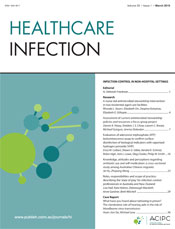
Healthcare Infection
Volume 20 Number 1 2015
Infection Control in Non-hospital Settings
HI15001Infection prevention and antimicrobial stewardship: important in all settings
In order to effectively prevent infection, and the development of resistant bacteria, infection control and antibiotic stewardship programs need to expand outside of hospitals. In prisons, infection control standards for regulated and safer tattooing practices could prevent infections, while in residential aged care a nurse-led program can result in a significant reduction in antibiotic prescribing. In order to comply with national standards, there is an ever-expanding scope of work for infection control practitioners that will require an increase in resources to successfully achieve.
HI14016A nurse-led antimicrobial stewardship intervention in two residential aged care facilities
Antimicrobial stewardship in a residential aged care facility setting is of growing importance. In this pilot study, we found that a simple educational intervention, utilising an infection prevention nurse to drive the program, led to a significant reduction in antibiotic use in a residential aged care facility. Further research in this important area is justified.
HI14016 Abstract | HI14016 Full Text | HI14016PDF (209 KB) Open Access Article
HI14025Assessment of current antimicrobial stewardship policies and resources: a focus group project
Describing the methods and results of a province-wide focus group project, the report revealed the participants’ perceptions of antimicrobial stewardship and formulary policies. Participants discussed the antimicrobial resources, influences, barriers, team approach, communication and educational needs, antimicrobial utilisation concerns, and enablers. This is the first qualitative analysis to target pharmacy services staff across a large organisation.
HI14022Evaluation of adenosine triphosphate (ATP) bioluminescence assay to confirm surface disinfection of biological indicators with vaporised hydrogen peroxide (VHP)
This study examined if ATP bioluminescence assay could be used to evaluate biological indicators to confirm decontamination following vaporised hydrogen peroxide decontamination. A reduction in microorganisms was shown for culture-based methods, but ATP bioluminescence assay did not show a reduction. The ATP bioluminescence assay is not an effective alternate to culture-based methodologies for the confirmation of VHP decontamination.
HI14034Knowledge, attitudes and perceptions regarding antibiotic use and self-medication: a cross-sectional study among Australian Chinese migrants
The inappropriate use of antibiotics in the community is an important contributor towards antibiotic resistance globally. This study identified misperceptions about antibiotic use in Australian Chinese migrants which significantly increased the risk of self-medication with antibiotics. It is of public health significance that health professionals are aware of the practice of self-medication and associated attitudes and perceptions about antibiotic use in this growing population.
HI14037Roles, responsibilities and scope of practice: describing the ‘state of play’ for infection control professionals in Australia and New Zealand
This study comprehensively describes the infection control professional workforce in Australia and New Zealand. It provides detail on ICP education levels, experience and highlights a diverse scope of practice. The results will help decision-makers to design and target strategies aimed at supporting infection control practice.
HI14037 Abstract | HI14037 Full Text | HI14037PDF (333 KB) Open Access Article
HI14032What have you heard about tattooing in prison? The clandestine role of hearing aids in the risk of bloodborne virus transmission
This report outlines the illicit use of hearing aid batteries as a power source for illicit prison tattooing. We advocate for the introduction of regulated tattoo parlours in prisons so as to minimise the risks of conflating important health interventions with risk activities and minimising the risks of bacterial or viral transmission.

